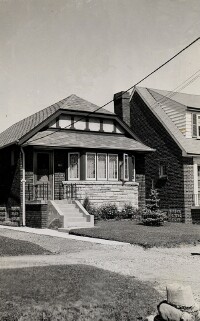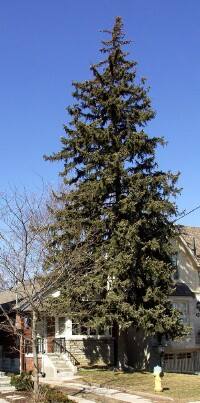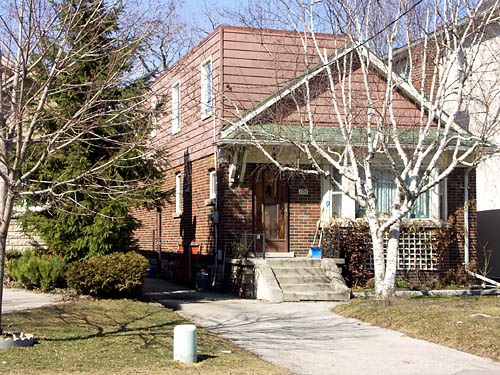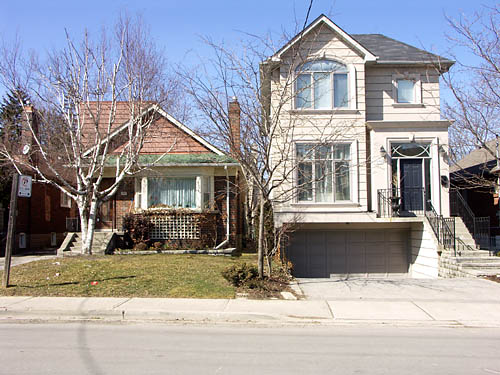These three squirrels have been socializing in our backyard for the last six weeks or so. I’m not entirely sure what they’re doing, but they all take turns in the middle and sure look like they’re enjoying themselves.



Random Wanderings and Wonderings
These three squirrels have been socializing in our backyard for the last six weeks or so. I’m not entirely sure what they’re doing, but they all take turns in the middle and sure look like they’re enjoying themselves.



Spring doesn’t seem in any particular rush to arrive so let’s take a final look back at the state of outdoor skating in this town. The city’s Parks and Environment Committee recently received an extensive review (PDF) of its outdoor skating rinks from the Centre for Local Research into Public Space (CELOS), the research arm of the Friends of Dufferin Grove Park. The paper casts an unflattering spotlight on the state of management of the city’s rinks, condemning everything from staffing and policy to signage and maintenance.
Although the problem rinks discussed in the report are rarely identified by name, they sound suspiciously like my two neighbourhood rinks in Riverdale Park and Withrow Park. Mind you, I’m sure that most rinks in the city suffer the same problems.
On the positive side, CELOS mentions that Toronto operates more outdoor artificial ice rinks than any city in the world. Rather than having one or two large central rinks, we scatter ours throughout the city’s neighbourhoods. It’s one of the small touches that makes Toronto unique.
The report provides interesting reading for people who skate — or refuse to — at their local rinks. Although it contains many common-sense and inexpensive recommendations, I anticipate resistance at council. I’m sure that at least a few councillors will interpret this report as “we have problems with many of our rinks, therefore we should close several and concentrate on running just a few.”
(Related: I reviewed some of the rinks I skated at this past winter. See the Rink Review category for the posts.)
I was just thinking that Torontonians expend a great deal of energy worrying about living in a world-class city, yet we never seem to make much world-class progress up the world-class ladder. In these early years of the 21st century, Google, in a world-class of its own, is still the most reliable and impartial judge of all things world-classy, so I thought I’d see just where we rank. A simple search for “world class city” shows these world-class cities ranked ahead of us:
Including duplicates, we rank a lowly 25th in the Google world-classiness list, making our first world-class appearance on the decidedly non-world-classy third page. Seriously, who ever clicks through to a third page of Google search results but world-class losers and desperadoes Googling their own names?
Now it may seem a little disconcerting at first glance to be behind such world-class powerhouses as Columbus and Sarasota. Even Vancouver inflicts a world-class bruise on our world-class ego by placing ahead of us. It would seem that we have a world-class struggle ahead to move up the world-class list.
But world-class wannabes should actually rejoice world-classily at the above list: we’re world-classier than New York City! And really, isn’t the world-class comparison to New York all that we care about? In fact, New York is so world-classless that it doesn’t appear anywhere in the first ten world-class pages of Google results. Now that’s something to celebrate. Quietly and with a world of class, of course.
(Even Google Canada’s results only rank us 7th on the world-classiness scale — still behind Columbus, still ahead of New York.)
One day after claiming that the city couldn’t find $80,000 to fund BikeShare, Councillor Glenn De Baeremaeker has suddenly found religion and is urging the city to spend over $17 million buying land in Scarborough. I now understand the problem with the BikeShare funding: the amount required simply wasn’t large enough. I mean, why dole out a few thousand dollars here and there when you can just blow it all on one big purchase? Makes perfect sense. Cuts down on administrative costs. You’ve got to spend money to save money.
Yes, I know that the land purchase and ongoing BikeShare funding are two completely different kinds of expenditures and it’s unfair to compare them. In fact, I think that the proposed Scarborough purchase would be a worthy expenditure and I support it. But the juxtaposition of the same councillor insisting that we’re too broke to afford an $80,000 program one day, and wanting to spend $17 million the next was just too juicy to ignore.
The Star reports today that after months of “shak[ing] the bushes and look[ing] under rocks,” councillor Glenn De Baeremaeker claims that the city has been unable to come up with a mere $80,000 to fund BikeShare so that it could continue to operate this year.
BikeShare is one of those community services that not only deserves to be funded, but that should be grown to ubiquity so that it becomes truly useful. Since our esteemed city council can’t find the money, allow me to offer up some bushes and rocks that De Baeremaeker may not have considered:
There you go, Glenn. Three minutes and I’ve shaken up over $250,000. You can not only fund BikeShare, but a few other worthy causes too. What’s your excuse now?
This issue is indicative of the malaise that infects Toronto council. Councillors sees nothing wrong with voting themselves raises because they make less than Mississauga councillors, catering themselves dinner because they have to work late, giving themselves free parking because they have to drive to work, handing themselves free Metropasses to encourage them not to drive to work, and on it goes.
While I don’t deny that councillors on the whole have a pretty thankless job that requires long hours, I don’t think they quite understand that many people are in the same situation, but don’t have the ability to simply award themselves perks. I can’t just give myself a raise because my next-door neighbour is making more money than me. If I’m working late, I run out to a restaurant and buy my own meal. If I have to drive to work, I feed the parking meter with my own coin. If I choose to take the TTC instead, I buy my own pass. And on it goes.
Toronto councillors preside over an $8 billion budget, yet can’t find a mere $80,000 in spare change. That’s the equivalent of someone who makes $80,000 a year not being able to find a loonie. It’s one thing to say that you don’t want to part with that dollar, and quite another to say that you don’t have that dollar. Geez pal, suck it up. Drink a coffee at home just one day a year instead of buying it at Tim Hortons, and there’s your buck right there. It’s not rocket science.
If this city is in such dire straits that accidentally dropping a loonie on the street will cause financial ruin, then councillors have no right to give themselves any perks or raises.
BikeShare is exactly the kind of program that Toronto must pay for if Mayor Miller is serious about making Toronto North America’s greenest city. If it’s to be taken seriously at all, Toronto council must find that loonie and fund BikeShare. And that’s just a start.
Although Toronto’s Doors Open gets the most attention around here (being the centre of the universe and all), it’s worth noting that communities of all sizes around Ontario have their own Doors Open weekends throughout the spring, summer, and fall.
In April and May alone, we have Doors Open Guelph, Brockville, Chatham-Kent, Hamilton, The Hills of Headwaters, North Bay, Orillia, and Toronto. It would be quite impossible for anyone to take in all of the Doors Open events around the province, it’s worth considering timing a road trip, camping weekend, or cottage escape with a local Doors Open near your destination. See the Doors Open Ontario web site for event details and calendars for each participating municipality.
The city has released the preliminary list of buildings taking part in Doors Open Toronto this year. Here are the locations I’m going to try to visit this year:
Two more posts will follow in a few days: one recommending sites I’ve visited on previous Doors Open weekends, and another lamenting buildings that are not taking part this year.


All it takes is a bit of time. This is my great-grandparents’ North York house around 1942 and again in 2007. The sapling they’d recently planted is barely a lawn ornament in the 1942 shot. Sixty-five years later, you can’t see the house for the tree.
I swore to myself when I started this blog that I’d never just post links to other people’s photos or YouTube videos. After all, if I found it on another blog, you could find it just as easily too. But this one is intriguing enough for me to temporarily break my vow.
I really wish that I had the metalworking skills to pull something like that off. I’m a pretty decent woodworker, but with only a handful of hours of welding under my belt, I’m still a few years away from being able to construct such a fantasy bike. It’s the perfect answer to all those signs throughout the city admonishing cyclists to walk our bikes across the road, the bridge, the driveway, and every other obstacle that could possibly lie between points A and B.
Back in the mid-70s, there was big controversy on Brooke Avenue in North York. The owners of 196 Brooke, just east of Avenue Road, wanted to add a second storey to the house to create room for their growing family. It was quite the scandal in this suburban neighbourhood dominated by bungalows.
Petitions circulated in protest and several residents declared that it would mark the end of the neighbourhood as they knew it.
The proposal didn’t even include a full second storey addition: the roof peak was only moving up by about six inches. In fact, it was closer to a shed dormer than a second storey, effectively a protrusion from the side of the attic that changed the shape of the roofline but had virtually no impact otherwise.

Granted, it’s not the prettiest addition ever to grace a house, but it’s hard to see what the uproar was about, especially considering that the street already hosted a handful of modest two-storey homes.
My great-grandparents lived a few doors up the street and were virtually alone in their non-opposition to the planned abomination. I remember listening from the kitchen one day when my great-grandmother told one of the petition-toting neighbours that it was none of her business if the family wanted to add to their house. It didn’t affect her one way or another and she didn’t understand why any of the other neighbours were so pig-headed. Even though the entire neighbourhood seemed to be against the development, North York council allowed the construction anyway.
Thirty years later, Brooke is one of those streets overrun by monster houses. In the block between Avenue Road and Elm Road, only 4 bungalows remain on the north side, surrounded by monster homes built within the last 20 years. A few more bungalows survive on the south side. The original monster house (on the left in the picture below) that caused the uproar 30 years ago now looks tiny compared to the true monsters that line the street.

But wait, there’s a bonus to this tale: one of the few bungalows left on the block is the one where my great-grandparents lived. The house of the only people who didn’t oppose development is among the small handful that haven’t since been developed. You can’t buy irony that good.